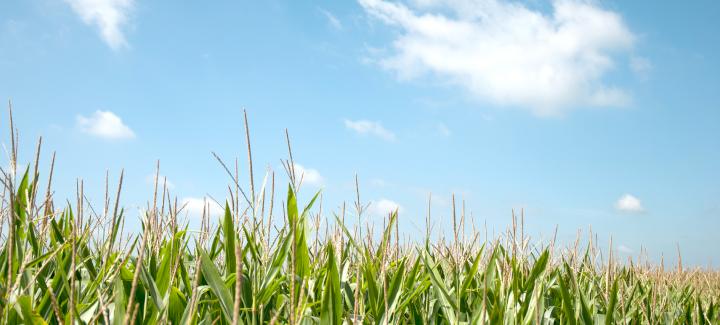
With 26% of the nation’s corn crop planted — twice the rate at this time a year ago — it’s not too early for growers to consider common corn diseases that might impact their crop this growing season. It’s important to understand what diseased corn looks like, when and why diseases occur, and how to stop or slow the spread once a field has been infected.
“Throughout the growing season, corn must fend off several diseases, such as northern corn leaf blight and tar spot, to thrive,” says Tom Larson, Stine’s director of agronomy. “Knowing what corn disease looks like, what type of disease it is and how to treat it is crucial to your corn crop’s survival and ability to reach its maximum yield potential.”
WHAT CAUSES CORN DISEASE?
For a corn disease to take place, three factors must coexist: a pathogen, a susceptible host and favorable environmental conditions — otherwise known as the disease triangle. Common corn diseases can include seed rots and seedling blights; later in the season, foliar diseases and stalk and ear rots can occur. Planting corn on corn can increase the risk of disease as many can overwinter in infested corn residual.
“There are a number of fungal and bacterial diseases of corn represented across the country,” says Larson. “Your corn crop is always vulnerable, so it’s important to research and understand the factors causing the disease in your field and how to move forward and mitigate it this season and into the next.”
WHAT ARE THE COMMON DISEASES OF CORN?
As a grower, you’re likely familiar with most corn diseases and how they can damage your production year after year, especially if not treated accordingly. The four most common types of corn disease are gray leaf spot, tar spot, northern corn leaf blight and common rust; however, it’s important to note there are still other less common diseases.
Gray leaf spot is caused by the fungus Cercospora zeae-maydis and occurs nearly every growing season. The gray leaf spot disease cycle begins when the fungus overwinters in corn residue and then spreads via rain and wind. It thrives in warm, wet environments and has symptoms similar to other foliar diseases. Spores germinate and infect leaves, causing lesions on the leaves that impact the lower part of the corn stalk and then move to the higher leaves as the disease progresses. Gray leaf spot can be detrimental to yield, and disease severity depends on hybrid susceptibility and environmental conditions. According to Purdue University Extension, the lesions on an infected plant can reduce the number of photosynthetic areas on leaves, which leads to fewer carbohydrates available to the developing grain. Scouting for gray leaf spot should take place a few weeks before and after tasseling around the V15 to R4 stage.
Like gray leaf spot, tar spot overwinters in corn residue. It is caused by the fungus Phyllachora maydis, and hot, wet conditions accelerate its spread. If left untreated, tar spot can cause leaf deterioration, poor grain fill, comprised stalks and even plant death. A severely impacted field can reach yield losses upwards of 60 bushels per acre. Tar spot symptoms include small, raised black spots that resemble fisheyes scattered on both sides of leaves. Scouting for the disease is recommended between the R3 and R6 growing stages.
Northern corn leaf blight is a common corn disease caused by the fungus Setosphaeria turcica. The disease thrives in cool, wet conditions and has a disease cycle similar to gray leaf spot and tar spot as it overwinters in the ground in corn residue. Northern corn leaf blight can be detected by tan streaks or lesions that are parallel to the leaf structure. Symptoms usually first appear on the lower leaves. The best time to scout for northern corn leaf blight is from V15 through R4.
Common rust in corn is caused by the fungus Puccinia sorghi and occurs every growing season. It is environmental and prolific in cool, wet conditions. It is rarely harmful to yield compared to grey leaf spot, tar spot and northern corn leaf blight. Common rust symptoms occur between V12 and R4 and include sporadic rust-colored pustules, which can be detected on both sides of the leaves.
HOW TO CONTROL COMMON DISEASES OF CORN
Proper corn disease management involves selecting corn products with genetic resistance to these diseases, using best management practices, such as tillage and crop rotation, and timely application of seed fungicides. Planting corn after corn is discouraged due to diseases lurking in crop debris. Additionally, avoiding poorly drained soils can prevent some diseases from taking over your crops. Planting at the right time and when the weather outlook is favorable can help keep diseases at bay. Early planting is recommended unless soils are excessively cold and wet.
Stine offers high-performing seed corn with the industry’s most desirable trait packages to help combat disease and yield loss. Reach out to your local Stine agronomist or sales rep for more information on how to treat common corn diseases and prevent them from infecting your crops next year.
Related Articles
-

Stine® to offer Syngenta’s Victrato® soybean seed treatment in 2026
December 2025 in Agronomy
-

Use Stine’s XP® seed treatments to prevent early injury to your crops
December 2025 in Agronomy
-

Understanding Stine’s enhanced oil profile soybeans
December 2025 in Agronomy
-

Soil sampling sets the stage for spring
November 2025 in Agronomy



